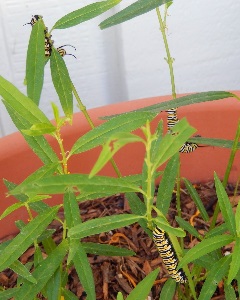
|
||
Raising MonarchsWhile planting milkweed and nectar plants is the best way to help the monarch migration, enthusiasts often raise monarch eggs, larvae and pupae they find in their yard. In fact, for many this has been a family tradition for generations and it is fun to continue this practice. Others like to raise a few monarchs for schools, public events, or others to enjoy. If you decide to do so, keep in mind these important points Raising Monarchs Safely Concerns with Mass Rearing
When the monarch population dropped significantly we all became aware of the need to plant more milkweed and nectar plants. At that time some people felt the best way they could support the population would be to raise monarchs and release them to increase their numbers. How they did this varied. We received many requests for referrals to purchase eggs and larvae from butterfly farms. Instead we encouraged growing more milkweed and nectar plants to support the monarch population in the Southwest. (We reported higher OE levels in farmed monarchs vs. wild monarchs in Arizona: Morris, G.M., Kline, C. and Morris, S.M., 2015. Status of Danaus plexippus population in Arizona. The Journal of the Lepidopterists' Society, 69(2), pp.91-107. You can download it here.) We added a link on our website to locate Plant Nurseries to help and feature seasonal plant sales. During the last few years reports of mass rearing of large numbers of monarchs have come to light, especially in the eastern range of the monarch population. Home breeders would raise hundreds to thousands of monarchs from immatures they collected. There are concerns over issues of higher incidence of diseases that can occur when these settings are not properly monitored. While OE is one well known possibility, without regular sanitizing there are other diseases and effects less well known or studied. Raising monarchs at home can be a highly emotional issue. Many well-meaning people respected in the monarch community have different opinions. We urge everyone to take time to read the different ways to approach this subject and make your personal decision. Keep in mind in a natural setting, only 2-5% of eggs laid by a female monarch become adults, due mostly to predation. Studies are showing that home reared monarchs do migrate like wild monarchs but at a lower success rate. We are lacking good studies that document the plusses and minuses of home rearing if done with responsible methods in reasonable numbers. No one can deny the educational value of children or adults witnessing a monarch eclose, or the importance of encountering monarch larvae chewing milkweed leaves or the beauty of a monarch chrysalis right in front of them in the proper setting. Recently the Monarch Joint Venture (MJV) released a new publication about rearing monarchs. The Xerces Society also shared a Blog Post . In the blog they mention, “a study of recoveries of tagged monarchs suggested that captive-bred monarchs have lower migration success compared to wild monarchs (Morris et al. 2015). This research suggests that captive-bred monarchs have lower fitness.” We urge you read our paper linked to in an earlier paragraph in this regard. In it we say many tagged farmed monarchs were seen in the Phoenix region over the winter months. In other words, they responded to our temperatures and likely became breeding rather than migrating monarchs. Dr. Chip Taylor of Monarch Watch notes that they do not promote home rearing but neither do they discourage it. In Dr. Taylor’s experience most home rearing only lasts a few years due to the amount of work involved and little is known of the actual numbers produced. “We don’t know how many monarchs are reared. What is that scale versus 69 million wild monarchs?” We need better studies and hopefully in the future more data will be available. The important thing right now is to get milkweed in the ground and continue studying the monarch migration and breeding patterns in the Southwest. Let’s make sure our disagreements in this area don’t become a distraction to reaching this goal. We urge you to read these and email us with any questions or concerns you may have: info@swmonarchs.org. Raising Monarchs SafelyIf you decide to raise small numbers of monarchs at home be sure to follow these recommendations:
|
||
|
Unless specified otherwise, all data Copyright © 2010-2021 Southwest Monarch Study Inc. Information from this site may not be copied or distributed without prior written approval from Southwest Monarch Study |
|
Webdesign Copyright © 2010-2020 Southwest Monarch Study Inc. |


